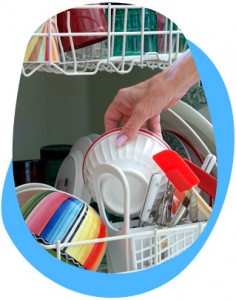Electricity is the usual choice for lighting and for running all those appliances upon which we have become so dependent: televisions, radios, hi-fi, microwave cookers, dishwashers, washing machines, fridges and freezers, coffee grinders, food mixers, computers, hair dryers, shavers, electric toothbrushes… The list of electrically-powered products is almost endless, and ever-increasing!
Low energy lighting
If every British household replaced just one 100W bulb with a 20W CFL (compact fluorescent lamps – CFLs) lightbulb, the energy saved would be equivalent to that produced by Sizewell B nuclear power station. They can be bought on-line from Sust-it’s lighting shop and from The Centre for Alternative Technology Green Shop, who also sell a ‘Bright Ideas’ tipsheet, and other many electrical suppliers. Halogen lights, often used in desk lamps and kitchens, are lower energy and very bright, but get hot (wasted energy!). LED equivalent replacement bulbs are available and are GU10 LEDs as bright as Halogens.
Modern LED bulbs are a real alternative to compact fluorescent lightbulbs (CFLs). They are compact and often dimmable, plus they have the advantage of reaching full brightness immediately. For more information on how to choose LED light bulbs, brightness, colour and lifespan can be found here.
Lighting ‘hints and tips’
Don’t leave lights on unnecessarily and if you feel lighting is needed for security consider using timers or movement detectors to turn them on and off. To make the most of your electric light, keep the bulbs clean and don’t use dark coloured lampshades which obscure the light. Carefully-placed mirrors can make a room seem lighter. If you want a change from electric light there are always candles but do be careful how you use them!
Electrical appliances
 How many do you need? Previous generations managed with none or very few. Some are clearly useful but others are less essential. It is quite possible to keep warm in bed, shave, brush one’s teeth, dry one’s hair, grind coffee and make toast, among many other tasks, without using electricity. To find out just how much appliances cost to run and see the CO2 emissions visit sust-it.net.
How many do you need? Previous generations managed with none or very few. Some are clearly useful but others are less essential. It is quite possible to keep warm in bed, shave, brush one’s teeth, dry one’s hair, grind coffee and make toast, among many other tasks, without using electricity. To find out just how much appliances cost to run and see the CO2 emissions visit sust-it.net.
Don’t leave electrical appliances on standby as they still use electricity while on standby, though modern standards mean less is used. Check your electricity meter readings or use an energy monitor, available from electrical stores such as Maplins to measure how much electricity you are using.
Timers can be useful if you need to turn appliances on or off at particular times.
There is a growing range of gadgets which generate their own electricity from solar power or mechanical energy, such as wind-up radios and torches, and solar powered garden lights and chargers for batteries and mobile phones. The Green Shop has a good range of solar powered torches and chargers and also sells a solar door chime with a solar panel in the bell push. Many of the other online shops sell these sorts of items.
Even a wind-up radio takes energy to produce, of course. As ever, the greenest question to ask is – do I need this?